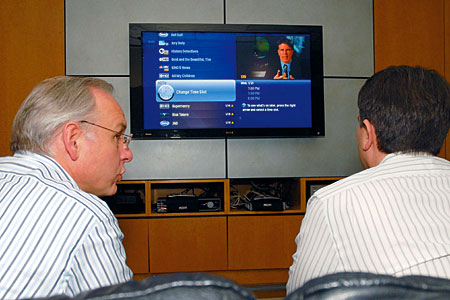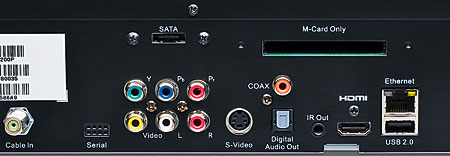Digeo Moxi HD DVR
 Price: $799 At A Glance: Superb user experience • Widgets! • Big storage with ability to scale higher • Works only with CableCARD • Not compatible with PPV or On-Demand • Can’t order pizza
Price: $799 At A Glance: Superb user experience • Widgets! • Big storage with ability to scale higher • Works only with CableCARD • Not compatible with PPV or On-Demand • Can’t order pizza
Pimping Your HD Cable Ride
DISH Network and DIRECTV have poached a lot of cable customers using the allure of their premium HD DVRs. Bigger storage, more robust features, a slick user interface, no cable company to deal with—it’s an easy sell most of the time. But what if you can’t or won’t do the dish and still want an enlightened HD DVR experience from digital cable? Digeo’s answer is the Moxi HD DVR. At its core, the Moxi is a high-end HD DVR that has a 500-gigabyte hard drive with a 75-hour HD capacity and the ability to add a ton of additional storage. On paper, the Moxi would be a compelling device even if this was all there was to it. But its DVR functionality is only the beginning. The Moxi is also a media hub that aggregates content from your home network and the Internet without bringing a full-blown media PC into your living room. Yep. Those newfangled widgets are inside. Let’s take a look.

The Moxi Model
As a sign of the times, Amazon.com is Moxi’s exclusive e-tailer.When you buy the Moxi directly through www.moxi.com, the Buy link hits Amazon. The Moxi HD DVR costs $799 up front, with no additional or recurring fees, ever. The only hidden cost is the fee for the Multistream CableCARD, which is about $5 per month. The Moxi works only with Multistream CableCARD, which allows you to record two HD programs simultaneously while watching HD content you’ve already recorded. You must be a digital cable subscriber, but you wouldn’t buy this if you weren’t. A broadband Internet connection that’s hard-wired to the Moxi’s Ethernet port is also required, and you need to hit Moxi’s Website from your PC to activate the HD DVR and your account.
By way of comparison, Comcast is charging me $16 per month for DVR service and an HD DVR. So my stock HD DVR has already cost me $382 over the two years I’ve had it. The other game in town for a premium cable HD DVR is the TiVo HD XL. It sells for $599. You still have the CableCARD charge, and you have to pay TiVo for DVR service. Annual service is $129, and a lifetime service contract is $399. It does include 1 terabyte of storage for 150 hours of HD, and it also has an eSATA port for expanding storage. So a TiVo HD XL with a lifetime of service is $998 up front.
There are a couple of drags in being tied to CableCARD, as both the TiVo and the Moxi are. You can get all of your premium cable programming (HBO, Showtime, etc.), but when you use CableCARD, it currently excludes you from consuming any On-Demand content that your cable provider provides. It also eliminates Pay-Per-View (PPV) programming. No PPV is the biggest drawback for me. I never miss a big PPV boxing event, so this Moxi would not fit the bill to be the sole cable box in my house. Tru2way might change this down the road, and Digeo is already making plans in that area. But supporting Tru2way would require you to invest in a new Moxi hardware platform, so bear that in mind.

A final, temporary buzz kill is the Moxi’s incompatibility with switched digital video (SDV), which some cable systems use to conserve precious bandwidth. Digeo is in testing now and promises a summer rollout for SDV support. Check with your provider—if your system uses SDV, your number of accessible channels could be limited until the Moxi update arrives.
Speaking of updates, Digeo rigorously tests and then pushes firmware updates silently to its boxes. Unlike a growing legion of CE devices, users don’t have to go through a process to check for updates and install them.
Scaling Storage
Comcast rents me an HD DVR with 30 hours of HD recording capability, which is the best they had two years ago. While the box I rent from them has an eSATA port, Comcast won’t activate it. So to make space for new recordings, I constantly have to dump HD content I’ve recorded but haven’t gotten around to watching. If Comcast has a newer and better DVR with expanded storage, they haven’t told me about it.
The Moxi ships with a 500-GB hard drive that’s good for 75 hours of HD (or 300 hours of SD material, however unworthy it may be). Better still, the eSATA port is active and fully supported. You can hang an additional 2 TB of storage off this port. Any additional storage adds to the 500 GB on board; it doesn’t replace it. Moxi specs demand a hard drive “marketed or certified for DVR use” that spins at a minimum of 7,200 RPM and is at least 160 GB. Checking on Amazon, you can buy a DVR-compatible 500-GB drive for as low as $128, and a 1-TB drive is just under $200 (at this moment). If you’re keeping score at home, a Moxi that’s expanded to 1.5 TB is about the same price as a TiVo XL HD with a lifetime contract. When you connect storage, the Moxi formats it quickly, and you’re up and running with the increased storage seamlessly integrated into the scheduling and storage interface.
The Quick Start Is the Only Start
The box is a simple glossy black rectangle—kind of like the monolith from 2001: A Space Odyssey laid on its side, with a lit, smoky-gray Moxi logo on the front. (Thoughtfully, the logo lighting is easy to defeat in the Settings menu for a darkened theater environment.) The only other buttons on the front panel are a nearly invisible black Reset button and a set of simple menu navigation buttons that I never used. The back panel has component video and HDMI outputs, as well as coaxial and TosLink digital audio outputs. I only used the HDMI output. In addition to the CableCARD and e-SATA ports, it also has a USB 2.0 connection.
Your mileage with your cable provider will undoubtedly vary, and we’ve all heard the horror stories. But Comcast was easy on me. They offered me a service call to install the multistream CableCARD at the earliest opening (10 days or so, around the impacted holidays) or said that I could pick one up at one of their offices. No guff whatsoever. My wife picked it up for me the next day while she was running errands.
The Start Up guide indicates a 45-minute setup, but it didn’t take me that long. The Moxi gives an ID number for your box, and then you need to go to your PC and hit the Moxi Website to register and activate it. The site e-mails you an eight-digit registration key that you then enter into the Moxi. Then you’re back on the phone with the cable company to activate the CableCARD, and you’re good to go. Again, Comcast was swift with this and offered no resistance.

The only other pertinent setup issues are choosing the video resolutions that your display supports and setting up the audio output. On the audio front, it’s simple: mono, stereo, or Dolby Digital (I chose the latter, obviously). On the video side, all the usual suspects are here: 480i/p, 720p, 1080i, etc. For my 1080p display, I selected 1080i and 1080p 24 (just in case; I don’t know of any native 1080p/24 coming over cable), which resulted in 1080i signals output at their native rate with proper timing. Further, when I checked 480i/p, 720p, and 1080i, the Moxi output all of the signals at their native resolutions. This allows anyone with high-end video processing in their surround processor, AVR, or display to engage it.
Born in HD
Digeo makes much of the fact that there is nothing legacy about the Moxi HD DVR platform. On the hardware side, at its core, it’s a graphics-grade multimedia PC that’s built on a Linux operating system. And this makes sense. The Moxi is all about processing and crunching HD video streams. All of the Moxi’s graphics are rendered in HD, and it shows. I (almost) hate to keep beating the crap out of my Comcast box, but its graphics look like they were drawn on an Etch-a-Sketch compared with this.
And you’re never bored. A crisp live TV image or a recording that you’re playing back remains in the upper right corner no matter what you’re doing in the menus until you change channels or access different content. If you’re looking for greener grass on another channel or digging through your recordings, you’re not in a TV black hole while you do it. When Moxi info graphics occupy the bottom of the screen, the image scales back just enough to accommodate them. It doesn’t recede to anything that resembles standard def. The HD image gets a smidge softer, but not by much.
Perhaps another facet of having all this processing power is the Moxi’s HD image quality in general. It wasn’t possible to A/B this box with my Comcast box playing the same content, but my subjective impression when I viewed the Moxi on my front-projection system was that it had better clarity and pop with native HD programs. We’ve seen in DVD and even BD players that improvements in core video decoding and processing can improve HD image quality. And that could be happening here, FWIW.





























































